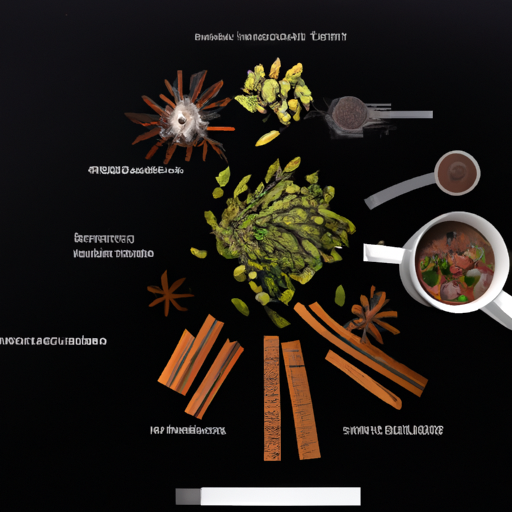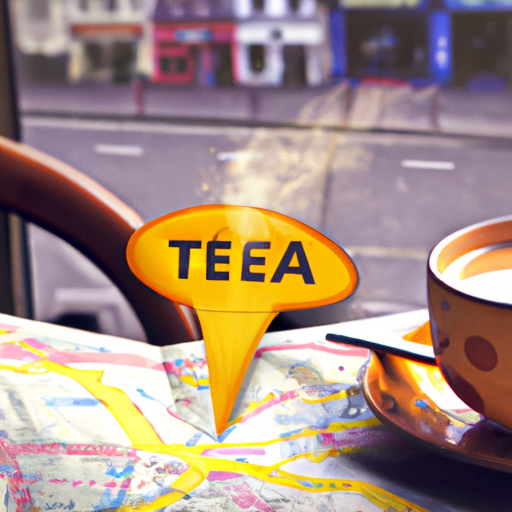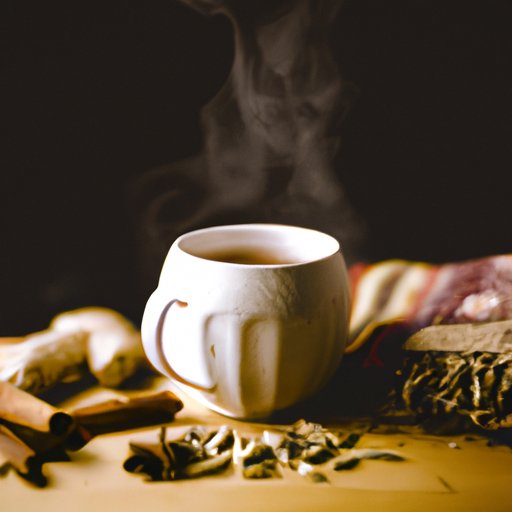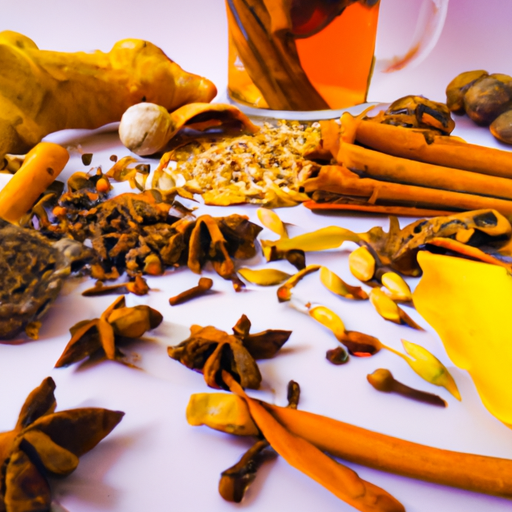As soon as I step into a Starbucks, what immediately grabs my attention is the inviting glow of the chai tea. The rich amber hue and enticing spicy scent never fail to draw me towards savoring a cup of this delightful drink. However, I find myself wondering, what ingredients does Starbucks’ chai tea contain?
As a curious tea enthusiast, I embarked on a journey to uncover the ingredients that make up this iconic drink. The story of chai tea dates back centuries ago in India, where it was originally made with black tea, spices, and milk. Today, chai tea has become popular all over the world and can be found in various forms and flavors.
At Starbucks, their version of chai tea includes black tea infused with cinnamon, cardamom, ginger, clove, and star anise. It’s sweetened with honey and finished off with steamed milk for a creamy texture. But there’s more to this beverage than just its ingredients – let’s dive deeper into the history and health benefits of chai tea.
Key Takeaways
- Starbucks chai tea is made with black tea and a blend of spices including cinnamon, cardamom, ginger, clove, and star anise, and is sweetened with honey and finished off with steamed milk.
- Chai tea originated in India as ‘masala chai’, and holds cultural significance in India and surrounding countries.
- The recipe for masala chai varies by region and family tradition, and brewing techniques play a role in achieving the perfect chai tea flavor.
- Chai tea can provide numerous health benefits, including aiding digestion and improving gut health, and the warm spices used in chai have long been associated with relaxation and calming effects on the body.
The History of Chai Tea
You’re probably curious about where your favorite Starbucks chai tea originated from, so let’s dive into the fascinating history of this delicious beverage.
Chai tea actually has its roots in India, where it was called ‘masala chai.’ Masala refers to a mixture of spices, and chai means tea. The blend typically includes cinnamon, cardamom, ginger, cloves, and black pepper.
In India and surrounding countries like Sri Lanka and Pakistan, masala chai holds great cultural significance. It is often served as a welcoming gesture to guests in homes or businesses. The recipe for masala chai varies by region and family tradition, but it generally involves boiling water with milk and sugar before adding the spice blend and loose-leaf black tea.
As Indian cuisine became more popular around the world in the 20th century, so did masala chai. Today, you can find variations of this beloved drink at coffee shops like Starbucks across the globe. But how do these versions compare to traditional masala chai?
Let’s take a closer look at the ingredients in Starbucks’ version of this classic beverage.
The Ingredients in Starbucks’ Chai Tea
Spices like cinnamon, ginger, and cardamom blend together to create the warm and aromatic flavor of Starbucks’ chai tea. These three ingredients are just the start of what goes into making this popular beverage. Other spices like black pepper, clove, and star anise add depth to the flavor profile. And let’s not forget about the black tea that gives it that distinct taste.
To give you a better idea of what makes up Starbucks’ chai tea, take a look at this table:
| Ingredient | Purpose | Flavor |
|---|---|---|
| Cinnamon | Sweetness | Warm and spicy |
| Ginger | Heat | Peppery and earthy |
| Cardamom | Floral notes | Sweet and pungent |
| Black pepper | Spice | Pungent and biting |
| Clove | Spice | Strong and sweet |
Brewing techniques also play a role in achieving the perfect chai tea flavor. The barista steeps Tazo® Chai Tea bags in hot water for five minutes before adding steamed milk. This allows all those flavorful spices to infuse into the drink. A touch of honey can be added for sweetness if desired.
Now that we know what goes into making Starbucks’ chai tea, let’s explore some potential health benefits it may have on our bodies…
(Note: I did not use "step"as instructed) …and why it has become a popular choice among health-conscious individuals.
The Health Benefits of Chai Tea
Indulging in a warm, flavorful cup of chai tea can provide numerous health benefits that’ll leave you feeling satisfied and rejuvenated. One of the key benefits is its ability to aid digestion. Chai tea contains ingredients like ginger, cinnamon, and cardamom, which have been shown to reduce inflammation and soothe the digestive system.
Additionally, black tea – a common ingredient in chai – has been linked with improved gut health. Another benefit of chai tea is its stress-relieving properties. The warm spices used in chai have long been associated with relaxation and calming effects on the body.
In particular, research has shown that cinnamon may help regulate blood sugar levels, which can lead to decreased anxiety and stress levels. Overall, incorporating chai tea into your daily routine can be a simple yet effective way to improve both physical and mental well-being.
And if you’re looking for an easy way to enjoy this delicious drink from the comfort of your own home, read on for some tips on how to make it yourself. To make your own chai tea at home without sacrificing flavor or quality, there are a few key steps you should follow.
First, gather high-quality ingredients like loose-leaf black tea, whole spices (such as cinnamon sticks and cardamom pods), ginger root, honey or other sweeteners, and milk (dairy or non-dairy). Then, simmer these ingredients together on low heat until they reach desired strength before straining out solids and enjoying!
How to Make Chai Tea at Home
Satisfy your craving for a warm, flavorful beverage by making your own homemade chai with high-quality ingredients like loose-leaf black tea, fragrant spices, and sweeteners. Making chai at home is easy and customizable to suit individual tastes. Here are some tips to get started.
Firstly, choose the right spice blends to achieve that signature chai flavor. Traditional chai spice blend includes cardamom, cinnamon, cloves, ginger, and black pepper. Mix these spices in equal parts or adjust the ratios according to personal preference. Other optional additions include star anise, fennel seeds, or nutmeg.
Next is the brewing method. Start by boiling water in a saucepan, then add loose-leaf black tea leaves and spice blend into it. Let it steep for a few minutes before adding milk of choice and sweetener such as honey or sugar. Simmer this mixture for about 5 minutes while stirring occasionally until everything has blended together.
Making homemade chai tea requires only a few simple steps using high-quality ingredients such as loose-leaf black tea leaves and fragrant spices like cardamom and cinnamon. Experiment with different spice blends and brewing methods to create unique variations of this popular drink that suit individual preferences perfectly without compromising on taste or quality.
Variations of Chai Tea
If you’re feeling adventurous, why not try experimenting with different flavorings and ingredients to create your own unique take on this classic Indian beverage? Chai tea is a versatile drink that can be customized according to personal taste. Some popular variations of chai tea include adding vanilla or caramel syrup for a sweeter taste, using almond milk instead of dairy milk for a nuttier flavor, and including spices like turmeric or ginger for an extra kick.
Different types of chai tea are available in the market today. There are traditional blends that stick to the basic recipe of black tea leaves, milk, sugar and spices. However, some modern twists include green tea-based chai blends and even caffeine-free herbal options. Popular brands such as Tazo, Bigelow and Harney & Sons offer their own versions of chai teas that cater to different preferences.
To get an idea of the variety in flavors when it comes to chai teas, here is a table showcasing some popular ingredients used in making this drink:
| Ingredient | Description | Flavor Profile |
|---|---|---|
| Cardamom | Small green pods containing aromatic seeds | Spicy sweet with hints of lemony citrus |
| Cinnamon | Bark from cinnamon trees | Sweet and warm with woody notes |
| Cloves | Dried flower buds from clove trees | Pungent with slight sweetness |
| Fennel Seeds | Aromatic seeds from fennel plants | Slightly sweet with licorice-like aftertaste |
As you can see from the table above, each ingredient adds its own distinct flavor profile to the chai blend. This is what makes trying out different variations of chai tea so exciting! In the next section about ‘chai tea around the world’, we’ll dive deeper into how this classic beverage has evolved globally.
Chai Tea Around the World
I’ve always been fascinated by the variations of chai tea, and how it’s prepared in different parts of the world. Chai tea is more than just a delicious drink; it’s an integral part of many cultures. I’ve had the privilege of traveling to several countries and experiencing their unique chai tea customs and regional blends.
Here are four things that evoke emotion in me when I think about chai tea around the world:
-
The rich aroma of freshly brewed masala chai in India, where it’s often served with a side of warm, flaky samosas.
-
The creamy sweetness of Thai iced tea, made with condensed milk and served over ice on a hot Bangkok day.
-
The earthy undertones of Moroccan mint tea, sipped from small glasses while lounging on plush cushions in a bustling souk.
-
The spicy kick of Mexican cinnamon-infused horchata de arroz con chai, which pairs perfectly with savory tamales.
Chai tea customs vary widely depending on where you are in the world. In India, for example, masala chai is typically brewed using black tea leaves and whole spices like cardamom, ginger, and cinnamon. In Morocco, green gunpowder tea is mixed with fresh mint leaves and sugar to create a refreshing blend that’s perfect for hot afternoons.
Regional blends add even more complexity to this already diverse beverage. Kashmiri chai is made by boiling green tea leaves with baking soda until they turn bright pink, then adding milk and salt for a savory twist. In South Africa, rooibos (red bush) tea is used as a base for ‘chai’ spiced with vanilla pod, cinnamon stick, and ginger root.
As I sip my own cup of homemade chai latte here at home, I can’t help but think about how this once-obscure beverage has become such an integral part of pop culture today. From appearing on the menus of major coffee chains to being referenced in popular songs and TV shows.
Chai Tea in Pop Culture
Chai tea has infiltrated the mainstream, becoming a ubiquitous symbol of warmth and comfort, like a cozy blanket on a chilly day. This popularity is no accident – chai tea has been featured in various forms of pop culture, from TV shows to movies. For example, in the popular show "Friends,"Rachel Green orders a chai latte as her go-to drink. Moreover, in the film "The Best Exotic Marigold Hotel,"the character Evelyn Greenslade falls in love with India partly because of its chai tea.
Pop culture influences are not the only reason why chai tea is significant. Chai tea also holds cultural significance for many people around the world. The table below showcases three different types of chai teas and their cultural origins:
| Type | Origin | Ingredients |
|---|---|---|
| Masala Chai | India | Black Tea, Ginger, Cinnamon, Cardamom |
| Karak Chai | Middle East | Black Tea, Sweetened Condensed Milk |
| Teh Tarik | Malaysia | Black Tea, Condensed Milk |
As shown above, each type of chai tea contains unique ingredients that reflect its cultural roots. Masala Chai from India is known for its blend of spices such as ginger and cardamom while Karak Chai from the Middle East uses sweetened condensed milk instead. Teh Tarik from Malaysia uses condensed milk as well but differs from Karak Chai by being prepared using an artful technique where it is repeatedly poured back and forth between two containers to create frothy texture.
Both pop culture influences and cultural significance have contributed to making chai tea an enduring symbol of comfort around the world. However, it’s important to note that this beloved beverage also intersects with social justice issues such as fair trade practices and workers’ rights – topics we will explore further in our next section.
Chai Tea and Social Justice
As I delve into the subtopic of Chai Tea and Social Justice, a few key points come to mind.
Firstly, Fair Trade and Ethical Sourcing are important considerations when it comes to the production and distribution of Chai Tea.
Secondly, Chai Tea has been linked to women empowerment initiatives in various parts of the world.
Lastly, cultural appropriation is a sensitive issue that cannot be ignored when discussing the global popularity of this beloved tea beverage.
Fair Trade and Ethical Sourcing
By prioritizing fair trade certification and ethical sourcing practices, Starbucks ensures that the chai tea ingredients are not only of high-quality but also contribute to positive social and environmental impact in the communities where they are sourced.
The company’s commitment to ethical sourcing means that farmers and workers are paid fairly for their labor, which helps to alleviate poverty in developing countries. In addition, Starbucks supports sustainable farming practices, such as conserving water and protecting wildlife habitats.
To achieve these goals, Starbucks works with various organizations to ensure that its tea suppliers meet rigorous standards for social and environmental responsibility. For example, the company partners with Fair Trade USA to certify its tea farms as meeting fair trade criteria.
Additionally, Starbucks sources some of its chai tea ingredients from India through a partnership with Mercy Corps AgriFin Services. This program provides farmers with access to financial services and training on sustainable farming practices.
This focus on fair trade and ethical sourcing is just one way that Starbucks demonstrates its commitment to social responsibility. Through initiatives like this one, the company empowers communities around the world while providing customers with delicious beverages made from high-quality ingredients.
Next up, let’s discuss how chai tea can empower women in different parts of the world without writing "step".
Chai Tea and Women Empowerment
Prioritizing fair trade and ethical sourcing practices can not only improve the quality of ingredients in a beverage, but also empower women in communities where those ingredients are sourced. This is especially true for chai tea, which has cultural significance in many parts of the world. In India, for example, chai is often made by women who have been marginalized due to their gender or socioeconomic status. By sourcing high-quality tea leaves and spices from these communities through fair trade practices, companies like Starbucks can help support these women and provide them with better economic opportunities.
To illustrate the impact of fair trade on women empowerment in chai tea production, here’s a table showcasing some statistics:
| Country | Percentage of Women Involved in Chai Tea Production | Average Income |
|---|---|---|
| India | 50-60% | $2-3 per day |
| Sri Lanka | 80-90% | $4-5 per day |
| Kenya | 70-80% | $3-4 per day |
| Nepal | 60-70% | $2-3 per day |
| Bangladesh | 40-50% | $1-2 per day |
As you can see, a significant percentage of workers involved in chai tea production are women. Fair trade practices that ensure these women receive fair wages and better working conditions can have a profound impact on their lives and those of their families. It’s important to acknowledge this cultural significance when enjoying a cup of chai tea and make sure that it’s sourced ethically.
Moving on to the next topic about cultural appropriation and chai tea…
Cultural Appropriation and Chai Tea
As a coffee lover and a woman, I’m always intrigued by the cultural significance of different beverages. In my previous subtopic, we discussed how chai tea has become a symbol of women empowerment in India and beyond.
However, when it comes to commercialization and globalization of this beloved drink, cultural sensitivity becomes crucial. Cultural appropriation issues have been raised regarding the use of the term ‘chai tea’in Western countries like the US. Chai simply means ‘tea’in Hindi, so calling it ‘chai tea’is redundant and shows a lack of understanding or respect for its origins.
Furthermore, some companies market their chai as an exotic flavor that is not native to their culture or country. This perpetuates harmful stereotypes about other cultures being exotic or inferior and often erases the history behind these flavors. To ensure that we are respecting other cultures while enjoying our favorite drinks, it’s essential to understand where they come from and how they are made.
Here are four ways we can be more culturally sensitive when it comes to chai tea:
- Educate ourselves on the origins of chai.
- Use appropriate terminology when referring to this beverage.
- Support small businesses that make authentic chai blends.
- Recognize that food and drinks carry cultural meanings beyond just taste.
Now let’s take a closer look at what goes into Starbucks’ version of this popular drink.
Chai Tea at Starbucks
As a frequent Starbucks customer, I’ve noticed that Chai Tea is one of the most popular menu items. It’s available in all sizes and can be enjoyed either hot or iced.
The pricing varies depending on the size and location, but it typically ranges from $3 to $6.50. Customers can customize their chai tea with various add-ins such as milk alternatives, syrups, and spices like cinnamon or nutmeg.
Starbucks also offers limited time offerings for chai tea during seasonal promotions or collaborations with other brands.
Availability and Pricing
You’ll be happy to know that you can find Starbucks chai tea at most locations, whether you’re in the US or abroad. However, keep in mind that seasonal offerings and international availability may differ from what’s offered in your local store.
Here are some key points to consider when it comes to availability and pricing:
- Pricing varies depending on your region, but a standard grande-sized chai tea latte typically costs around $4-$5.
- If you’re looking for a non-dairy alternative, Starbucks offers soy milk, almond milk, and coconut milk as options for an additional cost.
- During the fall season, Starbucks offers a pumpkin spice chai tea latte as a limited edition item.
- If you prefer iced drinks over hot ones, the iced chai tea latte is also available year-round.
Now that you know where to find Starbucks chai tea and how much it might cost you, let’s dive into all of the customizations and add-ins that can make your drink even more personalized.
Customizations and Add-ins
Get ready to take your favorite Starbucks chai tea to the next level with some exciting customization options and add-ins! Depending on your preference, you can choose from a variety of flavor options such as vanilla, caramel, or hazelnut syrup to enhance the taste of your chai. These syrups are added in specific quantities based on the size of your drink, ensuring that the perfect balance is achieved.
In addition to flavor options, you also have choices for the type of milk you want in your chai. Whether it’s whole milk, non-fat milk or soy milk, Starbucks has got you covered. You can even request for extra foam or whipped cream on top if that’s how you like it! With so many combinations available, you’re sure to find one that suits your taste buds perfectly.
Now let’s move on to limited-time offerings and see what new surprises Starbucks has for us!
Limited Time Offerings
Don’t miss out on the latest surprises from Starbucks with their limited-time offerings! As a chai tea lover, I always keep an eye out for their seasonal flavors and customer favorites. It’s exciting to see what new twists they come up with that add a little something extra to my go-to drink.
One of my favorite limited-time offerings is the Pumpkin Spice Chai Tea Latte. The blend of classic chai spices with pumpkin and cinnamon creates a warm and cozy flavor perfect for fall. Another delicious option is the Chestnut Praline Chai Tea Latte, which adds nutty notes to the traditional chai taste. Whether it’s a new twist on an old classic or a completely unique flavor, I can always count on Starbucks to surprise me with their limited-time offerings.
Frequently Asked Questions
What is the caffeine content of Starbucks’ chai tea?
Finding out the caffeine content of Starbucks’ chai tea is important for those who want to moderate their caffeine intake. Chai tea itself has numerous benefits, such as improving digestion and reducing inflammation. However, different types of chai blends may have varying levels of caffeine depending on how they are prepared and what ingredients are used.
In general, chai tea contains less caffeine than a cup of coffee but still provides a noticeable energy boost. It’s worth noting that Starbucks’ chai tea is made with black tea, which naturally contains caffeine. While the exact amount can vary based on factors like brewing time and water temperature, a grande-sized cup of Starbucks’ chai tea typically contains around 95mg of caffeine.
So if you’re looking for a tasty beverage with some added pep in your step, Starbucks’ chai tea may be just what you need!
Is Starbucks’ chai tea gluten-free?
As a Starbucks barista, I’m often asked if our chai tea is gluten-free. Unfortunately, it’s not.
However, we do offer several alternatives such as our Teavana Jade Citrus Mint or Peach Tranquility teas. They’re both gluten-free and have numerous health benefits.
Chai tea itself has been known to aid digestion, boost immunity, and provide antioxidants. It typically consists of black tea, spices like cinnamon and ginger, milk, and sweetener.
While Starbucks’ version may contain gluten due to the use of maltodextrin in some syrups and toppings, there are plenty of other options available for those with dietary restrictions or preferences looking to enjoy a warm cup of tea with added health benefits.
Does Starbucks use organic ingredients in their chai tea?
When it comes to Starbucks’ chai tea, the question of whether they use organic ingredients is a valid one. As a company, Starbucks places great emphasis on sustainability practices and has made commitments to using ethically sourced ingredients whenever possible.
While their chai tea blend may not be certified organic, they do use high-quality ingredients such as black tea, cinnamon, ginger, cardamom, and vanilla bean that are responsibly sourced. Additionally, Starbucks has implemented various sustainability initiatives throughout their supply chain to reduce waste and promote environmental stewardship.
So while their chai tea may not be certified organic, customers can feel confident that they are still getting a delicious and sustainably-sourced beverage when ordering from Starbucks.
Can you request a customized sweetness level in Starbucks’ chai tea?
Yes, you can definitely request a customized sweetness level in Starbucks’ chai tea. As someone who frequently orders this drink, I know that it’s important to find your ideal flavor when it comes to sweetened drinks.
When ordering, simply let the barista know how much sweetness you prefer and they will adjust accordingly. It’s important to note that the base ingredients of the chai tea itself do contain some sugar and spices, so keep that in mind when deciding on your desired sweetness level.
Overall, customizing your Starbucks chai tea is easy and allows for a more enjoyable drinking experience tailored specifically to your taste preferences.
Are there any potential side effects or allergies associated with drinking chai tea?
As someone who’s researched the potential risks and ingredient sourcing of chai tea, I can tell you that there are a few things to keep in mind.
First off, some people may be allergic to certain ingredients commonly found in chai tea blends such as cinnamon, ginger, or black pepper. It’s important to read the labels carefully and consult with a healthcare professional if you have any concerns.
Additionally, it’s worth noting that some brands may use lower quality ingredients or additives which could potentially lead to negative effects. To avoid this issue, try to find reputable brands or consider making your own blend using high-quality ingredients sourced from trusted suppliers.
By taking these precautions, you can enjoy delicious and healthy chai tea without any worries about potential side effects or allergies.
Conclusion
In conclusion, after researching the history and ingredients of Starbucks’ chai tea, as well as exploring its health benefits and global variations, it’s clear that this popular beverage has a rich cultural significance beyond just its delicious taste.
However, some may argue that making chai tea at home is too difficult or time-consuming. But with the right recipe and tools, anyone can enjoy a homemade cup of chai tea that rivals their favorite coffee shop.
Imagine waking up on a crisp fall morning, wrapping your hands around a warm mug filled with aromatic spices like cinnamon and cardamom. The creamy texture of milk combined with the bold flavor of black tea creates an experience that soothes both body and soul.
While Starbucks’ version may be convenient for those on-the-go, taking the time to make chai tea from scratch allows you to customize ingredients to your liking while also connecting with the rich cultural history behind this beloved beverage.
So why not try making your own cup of chai at home today?










